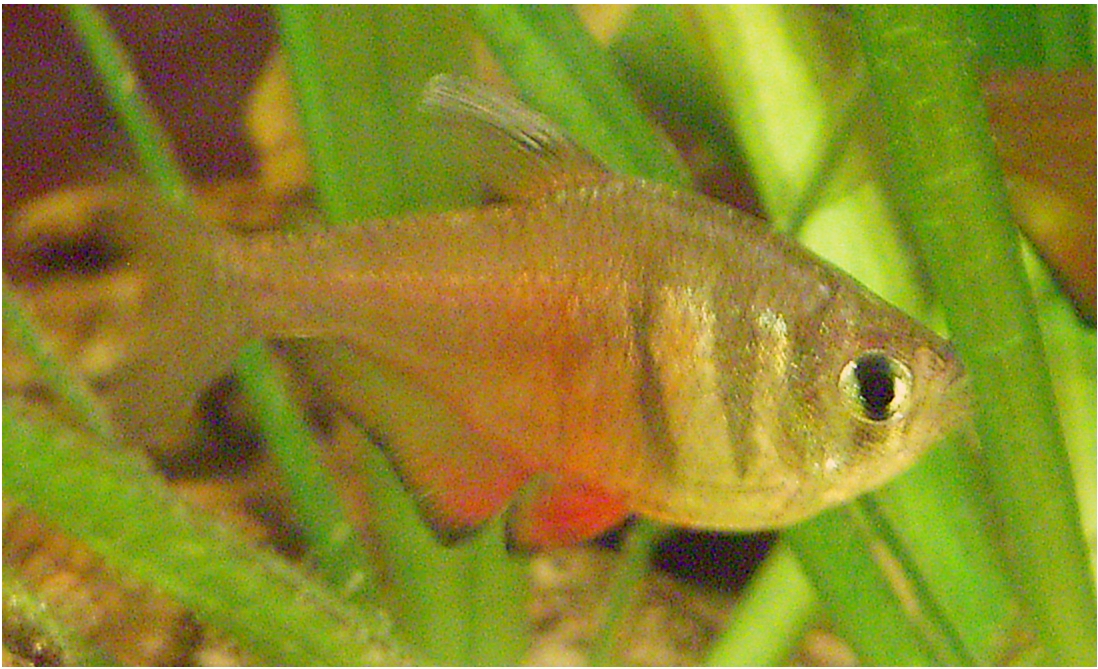- Flame tetra
image_width = 250px
image_caption = Flame Tetra (male)
regnum =Animal ia
phylum =Chordata
classis =Actinopterygii
ordo =Characiformes
familia =Characidae
subfamilia =Tetragonopterinae
genus = "Hyphessobrycon "
species = "H. flammeus"
binomial = "Hyphessobrycon flammeus"
binomial_authority = Myers, 1924The Flame Tetra ("
Hyphessobrycon flammeus"), also known as the Red Tetra or Von Rio Tetra, is a small freshwater fish of thecharacin familyCharacidae of orderCharaciformes . The species was first introduced as aquarium fish in 1920 by C. Bruening,Hamburg ,Germany , and formally described in 1924 by Dr.George S. Myers . [Myers, G.S. 1924. A new characin fish from Rio de Janeiro. - The Fish Culturist, 4: 330-331.] [Type series of 2 specimens, United States National Museum of Natural History, Smithsonian Institution,Washington D.C. , catalog number USNM 92969 (includes both specimens), see Vari, R.P. and Howe, J.C. 1991. Catalog of type specimens of Recent fishes in the National Museum of Natural History, Smithsonian Institution. 1. Characiformes (Teleostei, Ostariophysi). - Smithsonian Contributions in Zoology, 517: 1-52.]Cuba edited apostal stamp with an image of "H. flammeus" in 1978. [See image [http://www.fishbase.org/Photos/PicturesSummary.cfm?ID=10652&what=stamps here] , from: Froese, R. and Pauly, D. (eds.) 2007. FishBase. - WorldWideWeb electronic publication, www.fishbase.org, version 11/2007.]Habits, colouration and sexing
Geographical distribution
"H. flammeus" is found in slowly flowing rivers in the vicinity of
Rio de Janeiro inBrazil , South America. [Lima, F.C.T., Malabarba, L.R., Buckup, P.A., Pezzi da Silva, J.F., Vari, R.P., Harold, A., Benine, R., Oyakawa, O.T., Pavanelli, C.S., Menezes, N.A., Lucena, C.A.S., Malabarba, M.C.S.L, Lucena, Z.M.S., Reis, R.E., Langeani, F., Cassati, L. and Bertaco, V.A., 2003. Genera Incertae Sedis in Characidae. - In: R.E. Reis, S.O. Kullander and C.J. Ferraris, Jr. (eds.) Checklist of the Freshwater Fishes of South and Central America. Porto Alegre: EDIPUCRS, Brasil: 106-168.] The natural populations are locally endangered and listed in the Brazilian national red list [ [http://www.mma.gov.br/port/sbf/fauna/lista.html Brazilian national red list of endangered species] ] but not in the internationalIUCN red list. Commercially sold flame tetras are bred in captivity since capture and export from Brazil are prohibited.Aquarium keeping and breeding
"H. flammeus" should be kept in groups of more than 5 fishes in tanks from 60l volume onwards. It prefers water conditions at 22-28°C, pH 5.8 - 7.8, dH 5 - 25. The aquarium should contain a lot of water plants for hiding and some free water for swimming. Very bright illumination should be avoided. Keeping and breeding is unproblematical and the flame tetra can be kept in community basins. It is generally very peaceful but some individuals may behave occasionally aggressive.
In the wild, Flame Tetras feed on insect larvae, small Crustaceans and plant matter. In captivity they will happily feed on dried flake,Daphnia , mosquito larvae and frozen foods.
Breeding these fish in captivity is typical for most of theTetra family. These fish will spawn in both hard and soft water. However it is recommended that the parents are removed after spawning as they will eat the eggs. Flame tetras scatter about 200-300 adhesive eggs through plants; a large clump ofJava moss placed in the aquarium is ideal for this. The eggs hatch relatively quickly, in 24-36 hours, but the fry do not become free-swimming until several days later.Notes
Further references
Géry, J. 1977. Characoids of the World. T.F.H. Publications, Inc., N.J. 672p.
External links
1. "H. flammeus" at [http://www.fishbase.org/Summary/speciesSummary.php?ID=10652&genusname=Hyphessobrycon&speciesname=flammeus fishbase.org]
2. [http://atlas.drpez.org/Hyphessobrycon-flammeus-fotos Additional images] .
Wikimedia Foundation. 2010.

